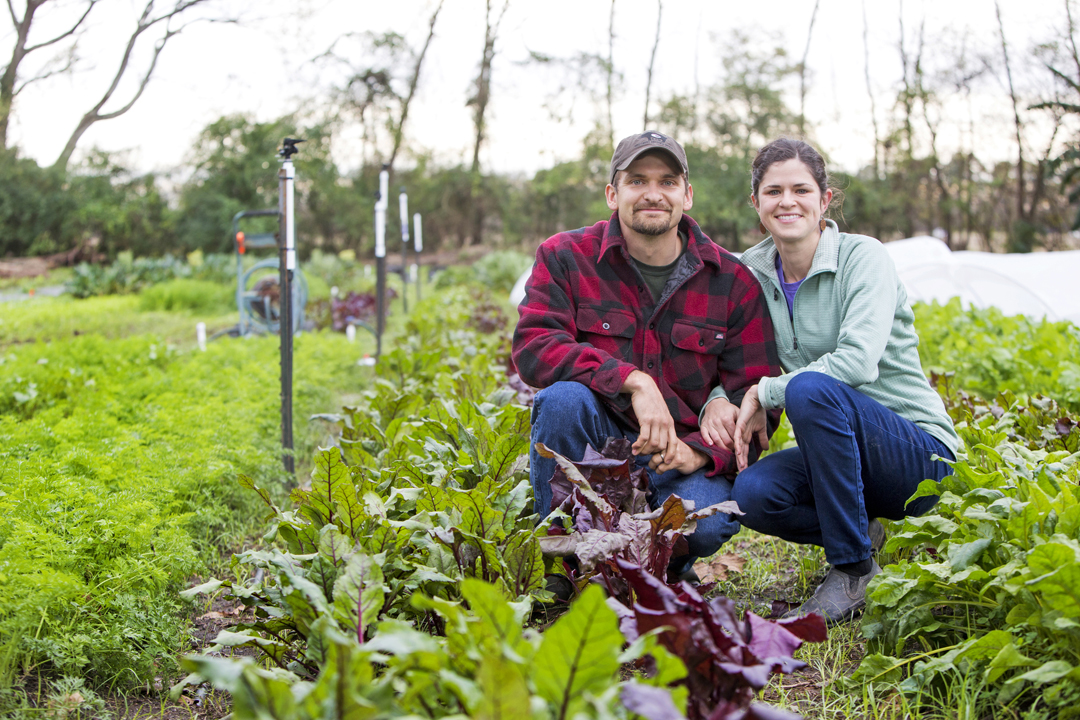
Spending a morning digging in the dirt at Fullness Organic Farm
Tippy Toes greets me before the farmers do. She’s a black-and-white mutt that could pass for a shepherding dog if there were any other animals to corral here.
But at Fullness Organic Farm, Tippy Toes doesn’t have many responsibilities except happily bouncing between rows of greens and stealing a baby carrot or two.
Arugula, spinach, Toscano kale, red Russian kale, tatsoi and a bunch of other types of organic greens I’ve never heard of all grow in the dark, rich dirt at Fullness, a small farm off Nicholson Drive near Gardere Lane.
|
|
The modest plot of crops on the old Longwood Plantation property—a half-acre oasis in a clearing away from all the nearby urban sprawl—is managed by young couple Grant and Allison Guidroz.
As Tippy Toes trots alongside us, Allison gives me a tour. “We focus on cool season crops,” she says. “We planned our whole farming year to start in October. That’s kind of how we think of the start of our season—all these crops here are really just starting to get to the time of year when it’s good for them to grow.”

The crops they grow have a quick turnaround of just a few weeks. That means the Guidrozes are harvesting and replanting constantly.
It’s nearing Thanksgiving when I visit, and while Grant is plucking greens for a spring mix that will likely be part of their holiday gatherings with friends, Allison is ready to put me to use and get some recently sprouted leeks into the ground. Though they began the farm solely with greens, the Guidrozes have since introduced vegetables like broccoli, cabbage, radishes, fennel and others to the farm.
We start with the watering system, extending a black plastic hose 50 feet across a row to trickle water into the soil. We cover the row with a long, narrow tarp that’s been pocked with equally spaced holes. Then comes the more laborious part: planting the leeks.
Allison demonstrates: She finds a hole in the tarp, drives a bare finger into the wet soil beneath it and places a leek with its fragile new roots into the hole. She carefully packs the soil in around it and moves on to the next hole.
Sounds easy enough, but we’ve got a lot of these leeks to plant. It doesn’t take long for her to get ahead of me, and after about 10 minutes of squatting and sideways frog jumps to move down the row, I’m already feeling it in my knees. What I’m not feeling is my hands. It’s a chilly, wet morning, the cold soil is clumping in my nail beds, and I’ve only bothered to ask why we weren’t wearing gloves at the halfway mark.
They rarely use gloves, Allison says, because she likes to feel the soil and the plants. Thin leeks make for meticulous work, and gloves would get in the way.
As we work, Allison tells me about what led them to start Fullness. Both LSU grads, they learned the ropes on a farm in Arkansas and Inglewood Farm near Alexandria.

They gained a passion for organic farming, plus tricks like using old vinyl billboards to cover the soil and kill grass, or repurposing washing machines to spin dry their greens.
They now sell spring mixes, individual varieties and microgreens at Red Stick Farmers Market. You might also find their leafy greens at Nino’s Italian restaurant and the online grocery delivery IndiePlate.
Of course, because the task at hand takes a little while, our conversation moves onto other topics, like their travels in Europe, the property’s old caretaker’s cabin that they’ve made livable, the telltale signs of another farmer when you cross paths at the grocery store, how they helped build a garden at Capitol Middle School, and the Harveston planned community that will soon swallow up the empty fields next door.
Eventually, Grant comes around to show us the greens he’s collected in a plastic bin, encouraging me to try the different varieties and note their range of flavors from nutty to bitter to sweet.
“We intentionally started small,” he says. “That was the advice we got from a lot of older farmers: ‘I don’t know what you think you want to do, but divide that in half.’ Starting small, you can focus a lot more on the quality.”
We finish planting the leeks, wash the dirt off our hands and munch on satsumas while strolling along the edges of the property.
Allison points out the additional land in the front past a grove of trees and closer to Nicholson Drive for them to expand, if they want.
But right here, tucked away from the urban development nearby, with rows of bright greens and vegetables ready to be harvested for the farmers market and Tippy Toes lying in the grass nearby … “Right now, this is perfect,” Allison says.
|
|
|

